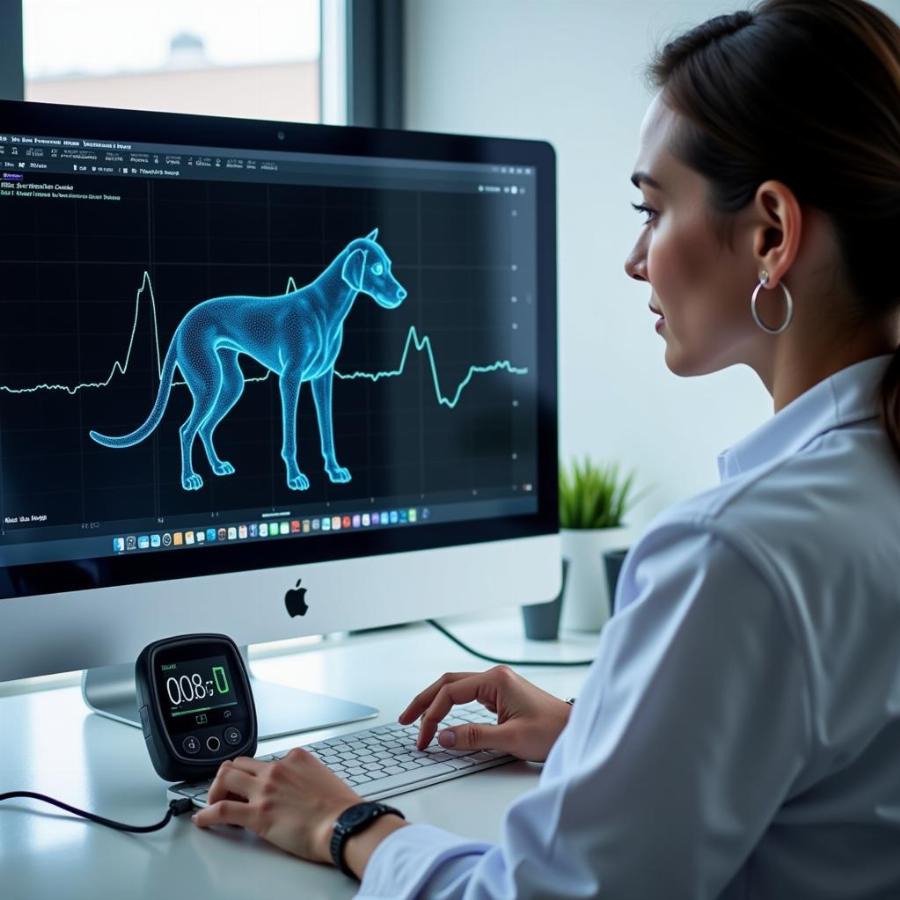A holter test for dogs is a non-invasive diagnostic tool used to monitor a dog’s heart rhythm over a period of time, typically 24 hours. It’s like a portable EKG that helps veterinarians identify and assess irregularities in the heart’s electrical activity that might be missed during a routine exam. This test is invaluable for diagnosing a range of heart conditions in dogs, providing crucial information for effective treatment.
What is a Holter Monitor and How Does it Work?
The holter monitor itself is a small, lightweight device that attaches to your dog’s harness or collar. It’s connected to electrodes placed on your dog’s chest, which detect and record the heart’s electrical impulses. Your dog can wear the monitor comfortably while going about their normal activities, allowing the veterinarian to capture a comprehensive picture of their heart function throughout the day. The data collected by the monitor is then analyzed to identify any abnormal heart rhythms or patterns. This information helps determine the type and severity of any underlying heart issues.
Why Would My Vet Recommend a Holter Test for My Dog?
Several signs might lead a veterinarian to recommend a holter test for dogs. These include fainting episodes, unexplained weakness, coughing, difficulty breathing, or if a heart murmur is detected during a physical exam. Sometimes, even if your dog isn’t showing any obvious symptoms, a holter test might be recommended if they belong to a breed predisposed to certain heart conditions. The test can help detect underlying heart issues early on, even before they become clinically apparent.
Preparing Your Dog for a Holter Test
Preparing your dog for a holter test is relatively straightforward. Your veterinarian will shave a small area of fur on your dog’s chest where the electrodes will be placed. The electrodes are attached to the skin with a special adhesive. It’s essential to keep the area dry, so avoid bathing your dog during the monitoring period. Encourage your dog to engage in their usual activities, as this helps provide a representative sample of their heart rhythm under normal conditions.
What to Expect During and After the Holter Test
While your dog is wearing the holter monitor, keep a log of their activities, including sleeping, eating, playing, and any unusual events or symptoms they exhibit. This information can help the veterinarian correlate the recorded heart rhythm with specific activities or events. Once the monitoring period is complete, you’ll return the device to the veterinarian for analysis. The results will be interpreted by a cardiologist or your veterinarian, who will discuss the findings with you and recommend any necessary treatment or further diagnostic tests.
Interpreting the Holter Test Results
Interpreting a holter test involves analyzing the recorded heart rhythm data for any abnormalities. The veterinarian will look for irregularities like arrhythmias, which are abnormal heartbeats that can be too fast, too slow, or irregular. The severity and type of arrhythmia detected can indicate the underlying cause and guide treatment decisions.
 Veterinarian reviewing Holter monitor data on a computer
Veterinarian reviewing Holter monitor data on a computer
Conclusion
The holter test for dogs is a valuable diagnostic tool for detecting and evaluating heart conditions. It provides a detailed assessment of your dog’s heart rhythm over an extended period, enabling veterinarians to identify irregularities that may be missed during a standard examination. Early detection of heart problems through a holter test can significantly improve a dog’s prognosis and quality of life.
FAQ:
- Is the holter test painful for my dog? No, the procedure is generally painless. Some dogs may experience mild discomfort from the shaved area or the adhesive used to attach the electrodes.
- Can my dog eat and drink while wearing the monitor? Yes, your dog can eat, drink, and engage in their normal activities while wearing the monitor.
- How long does it take to get the holter test results? The results are usually available within a few days after the monitor is returned to the veterinarian.
- What are the potential risks of a holter test? The risks are minimal and primarily involve skin irritation from the electrodes.
- What if my dog chews on the monitor? Discourage your dog from chewing on the monitor. If necessary, a protective cover can be used.
- How much does a holter test for dogs cost? The cost varies depending on the veterinary clinic and your location.
- What happens after the Holter test results are in? Your veterinarian will discuss the results with you and recommend the next steps, which may include medication, further diagnostic testing, or lifestyle changes.
Other questions you might have:
- What are the different types of arrhythmias in dogs?
- What are the treatment options for heart conditions in dogs?
- What are the long-term management strategies for dogs with heart disease?
Beaut Dogs is your trusted source for all things canine, offering comprehensive information and expert guidance on dog breeds, care, health, and well-being. When you need expert advice, contact us at Email: [email protected] to receive detailed and accurate information from Beaut Dogs. For more information about Holter monitors and other related topics, visit us at Beaut Dogs. You can also find more information on holter monitor for dogs, explore topics like arrhythmia intermediate vpc in dogs, or even check out our fun article on hot dog days to learn how to keep your furry friend cool in the summer heat.